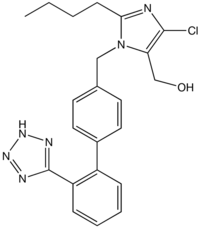Combination of ACE inhibitors and ARBs appeared no better than ACE inhibitor therapy alone and increased harms
 From the Annals of Internal Medicine:
From the Annals of Internal Medicine:Ischemic heart disease (IHD) is the leading cause of death of both men and women in the U.S.
Angiotension-converting enzyme (ACE) inhibitors or angiotensin II receptor blockers (ARBs) are typically introduced when patients have heart failure or a heart attack with ventricular dysfunction.
Researchers reviewed 41 published studies to compare the benefits and harms of using ACE inhibitors, ARBs, or a combination of these treatments in adults with stable IHD and preserved ventricular function.
The researchers found that adding ACE inhibitors to standard treatment improves clinical outcomes in these types of patients. However, a combination of ACE inhibitors and ARBs appeared no better than ACE inhibitor therapy alone and increased harms.
Image source: Losartan, the first ARB. Wikipedia, GNU Free Documentation License.